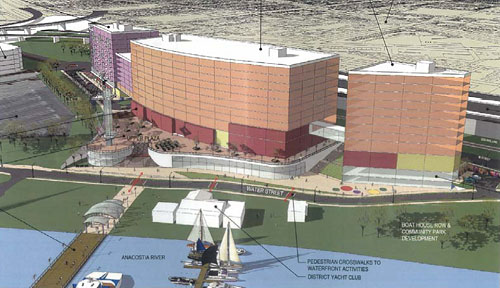NCPC worries about viewsheds in waterfront development
Thrusday’s National Capital Planning Commission meeting will consider a project along the Anacostia waterfront between the 11th Street bridges and the CSX railroad. Staff have objected to closing parts of “paper street” segments of Virginia Avenue, M Street, and 14th Street, SE.
The project, at 1333 M Street, SE, would build a large hotel and office building with ground-floor retail in the triangular area east of the 11th Street bridges and south of the CSX tracks along the Anacostia River. There would be a plaza on the river side of the building, with stairs down to another, lower plaza near the water’s edge.
Virginia Avenue and 14th Street, SE pass through the site as “paper streets,” not actually constructed or used as streets, but still part of the L’Enfant Plan. Part of Virginia Avenue would become a driveway to the project, and the portion farther east would be part of the plaza, not used as a street but kept as open space. Likewise, 14th Street, which was interrupted by the Southeast Freeway and CSX tracks, would stay as open space, but with a pedestrian bridge connecting the buildings on each side.
According to the NCPC report, DC worked out this deal with Cohen Companies (which owns the project) as part of a settlement over another lawsuit concerning the Southwest Waterfront. If the project doesn’t win necessary approvals, that settlement becomes void and Cohen can continue to pursue damages in the Southwest case.
The DC Historic Preservation Review Board approved the project and the formal closing of Virginia Avenue, 14th Street, and a small strip of M Street, provided that development doesn’t encroach on protected viewsheds. The question is how wide to keep the streets’ viewsheds: the original L’Enfant width or something narrower?
The L’Enfant Plan set aside very wide spaces for streets. Those “streets” are much wider than the actual roadways we have today; for many neighborhoods, they span the distance from the buildings on one side to the other, including the front yards, sidewalks, and tree box areas.
The “streets” are narrower in certain spots, however. Two triangular federal “reservations” make up the western and eastern ends of the planned buildings, and another one is part of the plaza. These reservations are areas set aside from the L’Enfant plan and have variously become triangular parks or buildings. Just like Farragut and McPherson Squares cut into the K Street right-of-way, making the street narrower in those areas, these reservations partly occupy the right-of-way for M and Virginia.
As a result, the remaining Virginia Avenue and M Street right-of-way are narrower next to the reservations than elsewhere. Cohen appears to have the right to develop on the reservations, meaning that at most, any viewshed would only be the width of the narrower part of the “streets.”
However, the NCPC staff report argues that there should be no development on any of the right-of-way for the streets, even where the right-of-way is wider than adjacent to the reservations. This would prohibit building even along the stretches which don’t actually maintain any viewsheds due to the developed reservations.
Complicating this is a legal dispute between DC and the federal government about an existing law that says DC may sell off these reservations. The law says,
Where title to the street or alley, of which all or part is to be closed, can reasonably be determined to be held by the United States or the District, the Council may dispose of the property to the best advantage of the District and may assess the fair market value of the land and the value of the District’s improvements on the land to the person(s) to whom the title to the land is to vest. Any money received for land where the title was held by the United States shall be deposited in the Treasury of the United States to the credit of the United States.
In a 1986 case, Techworld v. D.C. Preservation League over the closing of 8th Street, NW where it now passes between the Techworld buildings south of Mount Vernon Square, a court ruled for DC but the case was then settled. NCPC staff still feel that DC does not have the right to sell these portions of streets. The staff report also objects to the bridge over 14th Street.
If DC’s right to sell the reservations is valid, as it appears so far to be, then banning development on adjacent parts of the Virginia Avenue and M Street right-of-way doesn’t actually protect any viewsheds. More importantly, there isn’t much of a view to protect here. Virginia Avenue just turns into railroad tracks and a freeway, and 14th runs into the huge retaining walls between the tracks and the freeway.
The L’Enfant Plan’s vistas are important where those vistas actually exist. They don’t here, and even if the infrastructure one day went away somehow, they still wouldn’t. Nevertheless, this plan still preserves the vistas by maintaining a clear right-of-way for all of the original L’Enfant streets. The only question is how wide that right-of-way needs to be.



